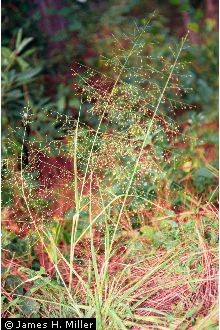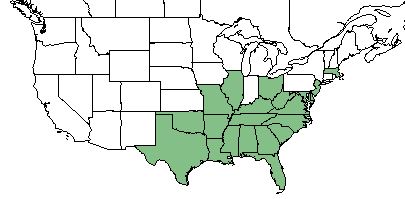Difference between revisions of "Eragrostis hirsuta"
(→Distribution) |
(→Ecology) |
||
| Line 33: | Line 33: | ||
===Habitat=== <!--Natural communities, human disturbed habitats, topography, hydrology, soils, light, fire regime requirements for removal of competition, etc.--> | ===Habitat=== <!--Natural communities, human disturbed habitats, topography, hydrology, soils, light, fire regime requirements for removal of competition, etc.--> | ||
''E. hirsuta'' is found in fields, roadsides, clearings, and disturbed habitats. <ref name= "Weakley 2015"> Weakley, A. S. (2015). Flora of the Southern and Mid-Atlantic States. Chapel Hill, NC, University of North Carolina Herbarium. </ref> Specimens have been collected from open flatwoods, small limestone glade, margin of shallow pond, open sand of vacant lot and other disturbed areas, hardwood hammock, mixed hardwood forest, and pine-oak woods. <ref name = "FSU herbarium"> URL: http://herbarium.bio.fsu.edu. Last accessed: June 2018. Collectors: Loran C. Anderson, Wilson Baker, R.K. Godfrey, Angus Gholson, Gary Knight, R.Kral, Richard Mitchell, Sidney McDaniel, Travis MacClendon, G. Wilder, K. MacClendon, Richard R. Clinebell II, D.L. Martin, S.T> Cooper, Ann F. Johnson, R.A. Norris, Cecil Slaughter, Bob Farley, M.J. Quinones. States and counties: Florida (Jefferson, Jackson, Clay, Leon, Franklin, Walton, Levy, Gadsden, Escambia, Suwannee, Dixie, Liberty, Taylor, Clahoun, Marion, St. Johns, Gulf) South Carolina (Richland) Georgia (Thomas, Grady)</ref> | ''E. hirsuta'' is found in fields, roadsides, clearings, and disturbed habitats. <ref name= "Weakley 2015"> Weakley, A. S. (2015). Flora of the Southern and Mid-Atlantic States. Chapel Hill, NC, University of North Carolina Herbarium. </ref> Specimens have been collected from open flatwoods, small limestone glade, margin of shallow pond, open sand of vacant lot and other disturbed areas, hardwood hammock, mixed hardwood forest, and pine-oak woods. <ref name = "FSU herbarium"> URL: http://herbarium.bio.fsu.edu. Last accessed: June 2018. Collectors: Loran C. Anderson, Wilson Baker, R.K. Godfrey, Angus Gholson, Gary Knight, R.Kral, Richard Mitchell, Sidney McDaniel, Travis MacClendon, G. Wilder, K. MacClendon, Richard R. Clinebell II, D.L. Martin, S.T> Cooper, Ann F. Johnson, R.A. Norris, Cecil Slaughter, Bob Farley, M.J. Quinones. States and counties: Florida (Jefferson, Jackson, Clay, Leon, Franklin, Walton, Levy, Gadsden, Escambia, Suwannee, Dixie, Liberty, Taylor, Clahoun, Marion, St. Johns, Gulf) South Carolina (Richland) Georgia (Thomas, Grady)</ref> | ||
| − | + | ||
| + | ===Phenology=== <!--Timing off flowering, fruiting, seed dispersal, and environmental triggers. Cite PanFlora website if appropriate: http://www.gilnelson.com/PanFlora/ --> | ||
| + | This species generally flowers from July until October.<ref name= "Weakley 2015"/> | ||
===Seed dispersal=== | ===Seed dispersal=== | ||
Revision as of 12:29, 7 May 2019
Common name: bigtop lovegrass [1]
| Eragrostis hirsuta | |
|---|---|

| |
| Photo from USDA NRCS Plants Database | |
| Scientific classification | |
| Kingdom: | Plantae |
| Division: | Magnoliophyta - Flowering plants |
| Class: | Liliopsida - Moncots |
| Order: | Poales |
| Family: | Poaceae |
| Genus: | Eragrostis |
| Species: | E. hirsuta |
| Binomial name | |
| Eragrostis hirsuta Michx. | |

| |
| Natural range of Eragrostis hirsuta from USDA NRCS Plants Database. | |
Contents
Taxonomic Notes
Synonyms: E. hirsuta var. hirsuta; E. hirsuta var. laevivaginata Fernald
Varieties: none
Description
E. hirsuta is a perennial graminoid of the Poaceae family native to North America. [1]
Distribution
E. hirsuta can be found along the southeastern coast of the United States from Texas to Massachusetts, excluding Indiana and Pennsylvania.[1] It is also native to Central America.[2]
Ecology
Habitat
E. hirsuta is found in fields, roadsides, clearings, and disturbed habitats. [2] Specimens have been collected from open flatwoods, small limestone glade, margin of shallow pond, open sand of vacant lot and other disturbed areas, hardwood hammock, mixed hardwood forest, and pine-oak woods. [3]
Phenology
This species generally flowers from July until October.[2]
Seed dispersal
This species is thought to be dispersed by gravity. [4]
Conservation and Management
Cultivation and restoration
Photo Gallery
References and notes
- ↑ 1.0 1.1 1.2 USDA Plant Database https://plants.usda.gov/core/profile?symbol=ERHI
- ↑ 2.0 2.1 2.2 Weakley, A. S. (2015). Flora of the Southern and Mid-Atlantic States. Chapel Hill, NC, University of North Carolina Herbarium.
- ↑ URL: http://herbarium.bio.fsu.edu. Last accessed: June 2018. Collectors: Loran C. Anderson, Wilson Baker, R.K. Godfrey, Angus Gholson, Gary Knight, R.Kral, Richard Mitchell, Sidney McDaniel, Travis MacClendon, G. Wilder, K. MacClendon, Richard R. Clinebell II, D.L. Martin, S.T> Cooper, Ann F. Johnson, R.A. Norris, Cecil Slaughter, Bob Farley, M.J. Quinones. States and counties: Florida (Jefferson, Jackson, Clay, Leon, Franklin, Walton, Levy, Gadsden, Escambia, Suwannee, Dixie, Liberty, Taylor, Clahoun, Marion, St. Johns, Gulf) South Carolina (Richland) Georgia (Thomas, Grady)
- ↑ Kirkman, L. Katherine. Unpublished database of seed dispersal mode of plants found in Coastal Plain longleaf pine-grasslands of the Jones Ecological Research Center, Georgia.